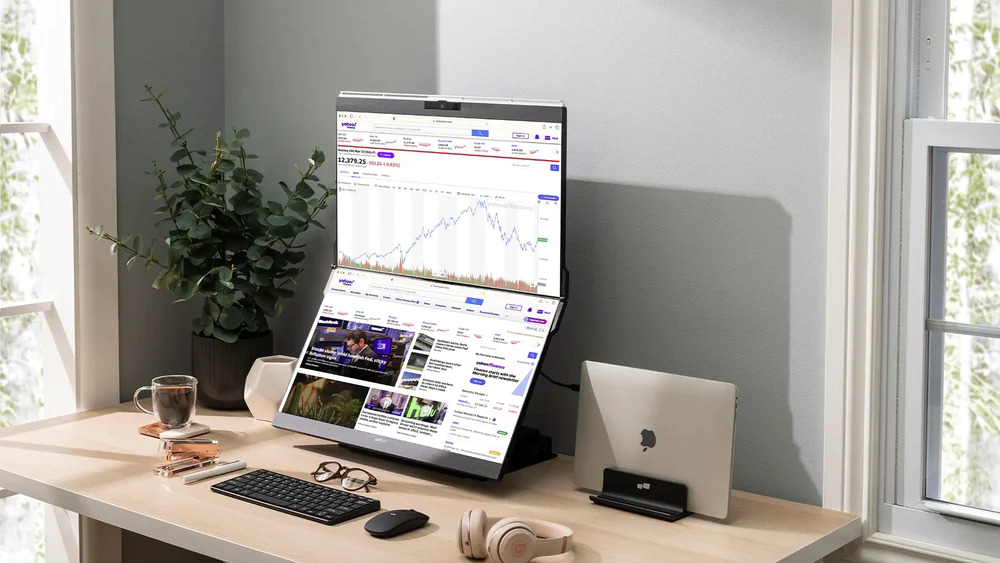In today’s fast-paced world, efficient multitasking, and seamless workflow management are paramount. Whether you’re a creative professional, a data analyst, a programmer, or simply someone who juggles multiple tasks, it is essential.
The proper monitor setup, such as Geminos stacked monitors, can significantly enhance your productivity. Among the various configurations, the stacked monitor setup has gained prominence. It is an effective solution to manage complex tasks and streamline your workflow.

In this article, we’ll explore the considerations and benefits of choosing the right stacked monitor setup tailored to your unique needs.
Factors to Consider While Choosing Right-Stacked Monitor Setup
A stacked monitor setup involves vertically aligning two or more monitors, creating a single extended display.
This configuration is particularly valuable for tasks that require vertical scrolling, such as coding, reading lengthy documents, and editing spreadsheets.
By stacking monitors, you maximize screen real estate without needing an expansive physical workspace. Here are the key factors to consider when choosing a stacked monitor setup. They are:
Assess Your Workflow Needs
Before diving into selecting monitors, take a moment to analyze your workflow. Identify the nature of tasks you frequently engage in.
Do you require extensive coding, data analysis, content creation, or a mix of these? Understanding your workflow needs is the foundation of choosing the appropriate monitor setup.
Screen Size and Resolution
The size and resolution of your monitors play a pivotal role in creating an effective stacked setup. Opt for monitors with consistent sizes and resolutions to transition between screens seamlessly.
A larger screen size provides more space for content, while a higher resolution enhances visual clarity. However, remember that a higher resolution demands more from your graphics card. So it is essential to ensure compatibility.
Ergonomics and Adjustable Stands
Ergonomics are crucial for prolonged comfort during work sessions. Look for monitors with adjustable stands that allow you to customize the height, tilt, and swivel angles.
This flexibility ensures that your monitors align with your eye level, reducing strain on your neck and eyes.
Aspect Ratio and Orientation
Consider the aspect ratio and orientation of your monitors. While the standard 16:9 aspect ratio is versatile, some professionals prefer ultrawide monitors (21:9 or 32:9). This ratio can enhance multitasking capabilities.
Additionally, determine whether you want a portrait or landscape orientation. Portrait orientation is ideal for coding and reading, while landscape orientation suits design and video editing tasks.
Color Accuracy and Calibration
Color accuracy is paramount for professionals in graphic design, photography, and video editing. Choose monitors with accurate color reproduction and wide color gamuts.
Some monitors come pre-calibrated, while others offer calibration tools to ensure consistent and accurate colors across the stack.
Bezel and Screen Gap
The bezel width and the screen gap between stacked monitors impact the visual experience. Thin bezels provide a seamless transition between screens.
It makes it easier to focus on content across monitors. Consider monitors with minimal screen gaps to create a cohesive and immersive display.
Connectivity and Cable Management
Ensure your monitors offer various connectivity options, including HDMI, DisplayPort, and USB-C.
This ensures compatibility with your devices and minimizes the need for adapters. Cable management is equally important to maintain a clutter-free workspace and prevent tangling cables.
Graphics Card Capability
A stacked monitor setup demands more from your graphics card, especially when dealing with high resolutions and multitasking. Ensure that your graphics card can handle the combined resolution of the stacked monitors without compromising performance.
Software and Multitasking Support
Specific software applications and operating systems offer features tailored for multitasking on stacked monitors. Investigate compatibility and explore functionalities such as virtual desktops, window snapping, and split-screen views.
Future Expansion
Consider your future needs when selecting a stacked monitor setup. Will you need to expand your setup by adding more monitors later? Opt for monitors that allow daisy-chaining or offer sufficient connectivity options for future expansion.

Benefits of a Stacked Monitor Setup
In the era of modern workspaces, where efficiency and productivity reign supreme. The benefits of a well-designed stacked monitor setup are undeniable.
This configuration, which vertically aligns multiple monitors to create an extended display, holds the potential to transform your workflow and elevate your overall experience. Here are some advantages this setup offers:
Enhanced Multitasking Capabilities
One of the standout advantages of a stacked monitor setup is its ability to supercharge your multitasking prowess.
With a broader canvas, you can seamlessly manage several tasks simultaneously without constantly switching between windows.
This capability is invaluable for professionals juggling data analysis, content creation, and project management.
Improved Productivity
A stacked monitor setup significantly mitigates the endless struggle of window switching. Having essential applications, documents, and information readily accessible across multiple screens is beneficial.
It allows you to maintain focus and momentum. It heightens productivity and a streamlined workflow that maximizes your valuable time.
Streamlined Workflow Management
The stacked monitor setup acts as a dynamic workspace where you can arrange windows and applications to mirror your workflow.
This management of screens creates a cohesive environment. This makes it easier to transition between tasks and maintains a clear sense of progress throughout your workday.
Better Organization and Access
Organizing your workspace becomes a breeze with the extended real estate of a stacked monitor setup. Whether comparing spreadsheets side by side, referencing research materials, or monitoring multiple data streams, having all pertinent information at a glance enhances your efficiency and decision-making.
Reduced Strain on Eyes and Neck
Ergonomics play a pivotal role in any workspace, and a stacked monitor setup aligns with this principle. Placing monitors at eye level and optimizing their orientation can significantly benefit you.
You can significantly reduce strain on your neck and eyes. The ergonomic advantage increases comfort during extended work sessions, promoting your well-being.
Final Thoughts
Selecting the right stacked monitor setup can revolutionize the way you work. Understanding your workflow, assessing your needs, and considering factors like screen size, resolution, orientation, ergonomics, and future expansion is vital.
You can design a stacked monitor setup that maximizes productivity and enhances your overall working experience.
Whether a creative professional seeking a canvas for your imagination or a data analyst juggling complex datasets, a carefully curated stacked monitor setup is your gateway to a more efficient and enjoyable workflow.









